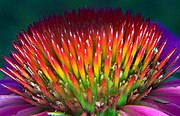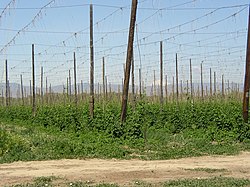HomeEchinacea
From Wikipedia, the free encyclopedia
- This article is about the flowering plant. For Superorder Echinacea (Echinodermata) see Sea urchin
Echinacea commonly called the Purple coneflowers, is a genus of nine species of herbaceous plants in the Family Asteraceae. All are strictly native to eastern and central North America. The plants have large showy heads of composite flowers, blooming from early to late summer. Some species are used in herbal medicines.

E. purpurea flower centre
The genus name is from the Greek echino, meaning "spiny", due to the spiny central disk. They are herbaceous, drought-tolerant perennial plants growing to 1 or 2 m in height. The leaves are lanceolate to elliptic, 10–20 cm long and 1.5–10 cm broad. Like all Asteraceae, the flowers are a composite inflorescence, with purple (rarely yellow or white) florets arranged in a prominent, somewhat cone-shaped head; "cone-shaped" because the petals of the outer ray florets tend to point downward (are reflexed) once the flower head opens, thus forming a cone.

A
Bee on an
Echinacea paradoxa flower
[edit] Species
The species of Echinacea are:

The spiny flower center from which the name derives
[edit] Health effects
Echinacea is popularly believed to stimulate the body's immune system and ward off infections, particularly the common cold. However, its clinical efficacy has not been established.[1]
[edit] History
Echinacea angustifolia rhizome was used by North American Plains Indians, perhaps more than most other plants, for various herbal remedies. Echinacea was one of the basic antimicrobial herbs of Eclectic medicine in the mid 1800s through the early 1900s and its use was documented for snakebite and anthrax. In the 1930s "Echinacea" became popular in both Europe and America as a herbal medicine.
[edit] Active substances
The full spectrum of echinacea's chemical components responsible for its health effects are not well understood. Like most crude drugs from plant or animal origin, the constituent base is complex and some parts may be directly antimicrobial while others work at stimulating or modulating different parts of the immune system. All species have chemical compounds called phenols, which are common to many other plants. Both the phenol compounds Cichoric and caftaric are present in E. purpurea, other phenols include echinacoside, which is found in greater levels within E. angustifolia and E. pallida roots than in other species. When making herbal remedies, these phenols can serve as markers to evaluate the quantity of echinacea in the product. Other chemical constituents that may be important in echinacea health effects include alkylamides and polysaccharides.
[edit] Root or whole plant
A medical study (Taylor et al. 2003[2].) found that when echinacea products made from the entire plant (not just the root) were taken after the second cold symptom appeared they provided no measurable beneficial effect for children in treating the severity or duration of symptoms caused by the common cold virus. Dosage however was about a third of what clinical herbalists routinely use, and the leaves and stems are not known to be clinically effective. Studies by the University of Virginia School of Medicine (Turner, 2005 [3]) confirmed these results, and added that Echinacea had no clinically significant effects on the common cold even if taken immediately upon infection, or as a prophylaxis starting a week prior to symptoms of infection. However, a University of Maryland review of available studies concluded that Echinacea, when taken at first sign of a cold, reduced cold symptoms or shortened their duration. This conclusion was based on 13 European studies.[4] The University of Maryland study also found that three of four studies concluded that taking Echinacea to prevent a cold was ineffective, although including studies that use subclinical doses, the wrong part or unassayed material will bias such conclusions. Another scientific review, however, of 14 published studies found that the incidence of colds was reduced by 58% and the duration by a day and half.[5]
[edit] Alcohol-based or dry
Leading herbalists claim that many studies do not distinguish between alcohol-based echinacea tinctures, which retain potency for up to seven years after production, and capsules containing the dried herb, which lose their efficacy over time.[citation needed] Capsules not only lose strength, but must be digested in the stomach while alcohol tinctures enter the lymphatic system through the tongue.
[edit] Frequency of administration
Proponents of echinacea assert that it is not a "one-dose" treatment, and that in order to work effectively, a dose should be taken at the very first sign of a cold symptom. Subsequent doses must be taken every two to four hours after the first dose, including every two to four hours during the overnight sleeping period, until the cold symptoms have disappeared (generally within 24 hours.) The scientific studies stated above appear to disagree with these claims as ad hoc rationalising; if the cold doesn't go away when expected, the patient can always be blamed for not following the strict regimen, and the product is never to blame. This is known as subjective validation.
[edit] Species
Not all species of Echinacea are equally effective. A Cochrane review of the published studies [6] has found that there is some evidence of benefit in the treatment (but not prevention) of the common cold by the aerial parts of Echinacea purpurea; other formulations of the plant did not show the same effect, and no formulation was effective for prevention.
[edit] Contraindications
Echinacea herbals should not be taken by persons with progressive systemic and auto-immune disorders such as tuberculosis, leicosis, connective tissue disorders, collagenosis, and related diseases such as lupus erythematosus, according to the German Kommission E. Its use in AIDS or against opportunistic infections in AIDS patients is controversial: the Kommission E recommend against it. [7]. It should not be used with other known hepatotoxic drugs such as anabolic steroids, amiodarone (Pacerone® or Cordarone®), methotrexate, or ketoconazole (Nizoral®) [8].
[edit] Other uses
[edit] Medical
Echinacea may, in addition to common cold, be useful when treating Athlete's foot with Econazole, or in cancer treatment[9].
[edit] Others
Some species of Echinacea, notably P. purpurea, E. angustifolia, and E. pallida, are grown as ornamental plants in gardens[10] They tolerate a wide variety of conditions, maintain attractive foliage throughout the season, and multiply rapidly. Appropriate species are used in prairie restorations.

















![Hop umbel[citation needed] (branched floral structure resembling nested-inverted umbrellas) in a Hallertau hop yard](http://upload.wikimedia.org/wikipedia/commons/thumb/e/e8/Hopfendolde-mit-hopfengarten.jpg/250px-Hopfendolde-mit-hopfengarten.jpg)







